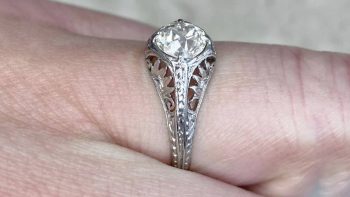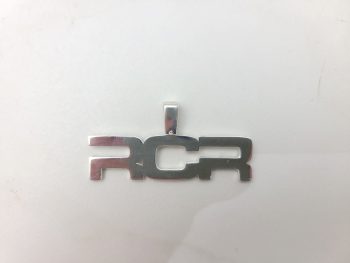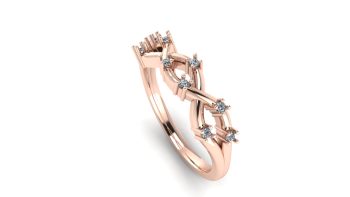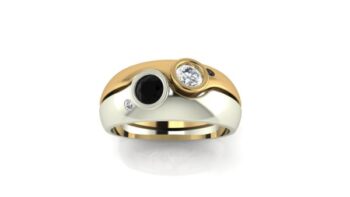Pinpoint Inclusions In A Diamond
Choosing the perfect diamond can be a time consuming and confusing ordeal for some. On top of needing to pick a color and clarity for the stone, there are a host of other issues that must be looked at. These include cut, symmetry, polish, and fluorescence. If you haven’t been trained or educated in looking at diamonds, it can be overwhelming and stressful. You want to get the best stone for your money. Everyone does. So, in this post, we will discuss one of the most common types of diamond inclusions. Pinpoints. We will go over everything you need to know about pinpoints and how they can effect your stone, its value, and it’s beauty.
What Are Pinpoint Inclusions In A Diamond?
Pinpoint inclusions are tiny, often microscopic, imperfections that can be found within the stone. These inclusions are formed during the diamond’s growth process and can vary in size, shape, and color. While they may seem like flaws, pinpoint inclusions are actually a natural part of a diamond’s formation and can even be seen as unique characteristics that make each diamond special.
Pinpoint inclusions can take on different forms, such as tiny crystals, clouds, or even small fractures within the diamond. They are typically only visible under magnification and do not affect the overall beauty or brilliance of the stone. In fact, some people even consider pinpoint inclusions to be a desirable feature, as they can add character and uniqueness to a diamond.
While pinpoint inclusions in a Diamond may not impact the diamond’s appearance, they can affect its clarity grade. The clarity grade of a diamond is determined by the number, size, and visibility of its inclusions. Diamonds with a higher clarity grade will have fewer and less visible inclusions. Conversely, those with a lower clarity grade may have more noticeable and numerous inclusions.
Basically, pinpoint inclusions in a diamond are natural imperfections that are be found within the stone. They add character and uniqueness to each diamond, and while they may affect the clarity grade, they do not diminish the overall beauty of the stone. So, the next time you come across a diamond with pinpoint inclusions, embrace its individuality and appreciate the natural wonders that lie within.
Are Pinpoint Inclusions In A Diamond Bad?
Pinpoint inclusions in a diamond can be seen as a negative aspect. These tiny imperfections can affect the overall clarity and brilliance of the diamond. However, it’s important to note that not all inclusions are created equal. Some inclusions may be barely visible to the naked eye, while others may be more noticeable. Ultimately, it comes down to personal preference and budget. If you prioritize a flawless appearance, then a diamond with minimal inclusions would be the way to go. However, if you’re willing to compromise on clarity for a larger carat size or a more affordable price, then pinpoint inclusions may not be a deal-breaker.
What Are Cloud Inclusions In A Diamond?
A group of pinpoints is called a cloud. There must be at least three pinpoints in the same area to be considered a cloud. When assessing diamond clarity, cloudy inclusions are more easily identified. A single point inclusion is difficult to detect, while clusters appear as larger marks.
Cloud inclusions in a diamond are tiny, wispy, cloudy formations that can affect the diamond’s clarity. These inclusions are made up of microscopic crystals or trapped gases that formed during the diamond’s growth process. While they may not be visible to the naked eye, they can still impact the overall appearance and value of the diamond. In our opinion, it’s important to consider the presence of cloud inclusions when evaluating a diamond’s quality.
Cloud inclusions can vary in size, shape, and density. Some may appear as faint, hazy areas within the diamond, while others can be more concentrated and noticeable. These inclusions can affect the diamond’s brilliance and sparkle, as they can interfere with the passage of light through the stone. As a result, diamonds with a high number or density of cloud inclusions may appear dull or less vibrant.
When purchasing a diamond, it’s essential to have a clear understanding of the presence and impact of cloud inclusions. Some inclusions may be acceptable, depending on personal preferences and budget. However, it is crucial to strike a balance between clarity and value. A reputable jeweler can help guide you in selecting a diamond with the right balance of clarity and brilliance, ensuring that you make an informed decision.
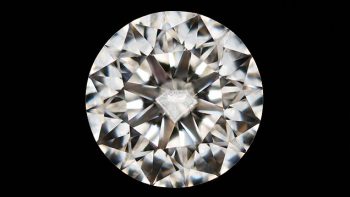
Are Clouds Worse than Pinpoints?
Cloud inclusions are an important factor to consider when evaluating the quality of a diamond. They can affect the diamond’s appearance and value, impacting its brilliance and sparkle. By understanding the presence and impact of cloud inclusions, you can make a more informed decision when purchasing a diamond. When grading a diamond, the grader will ding a diamond’s clarity score more for a cloud than the same number of pinpoints scattered throughout the stone. This is because a group of pinpoints will effect the overall blocking of light more than a bunch of scattered ones.
How To Locate Pinpoint Inclusions In A Diamond
When it comes to locating pinpoint inclusions in a diamond, there are a few key steps to keep in mind. First, you’ll want to make sure you have the right tools on hand. A jeweler’s loupe with at least 10x magnification is essential for this task. Next, find a well-lit area where you can examine the diamond closely. Hold the diamond up to the light and rotate it slowly, looking for any tiny specks or imperfections within the stone. It may take some practice and patience, but with the right tools and a keen eye, you’ll be able to pinpoint those inclusions in no time.
In our opinion, the key to locating pinpoint inclusions in a diamond is to be thorough and observant. Take your time and don’t rush the process. Remember, these inclusions can be incredibly small and subtle, so it’s important to pay close attention to every detail. Additionally, don’t be afraid to ask for assistance from a professional jeweler if you’re having trouble spotting the inclusions on your own. They have the expertise and experience to help you identify and understand the significance of any inclusions you may find.
Locating pinpoint inclusions in a diamond requires the right tools, a well-lit area, and a patient, observant approach. With practice and attention to detail, you’ll become more skilled at spotting these imperfections. Don’t hesitate to seek guidance from a professional if needed.
How to View Pinpoint Inclusions In A Diamond With A Loupe
When it comes to viewing pinpoint inclusions in a diamond with a loupe, there are a few key steps to follow. First, make sure you have a good quality loupe with at least 10x magnification. This will allow you to see the tiny inclusions clearly. Next, hold the diamond up to a light source and position the loupe about 4-6 inches away from your eye. Now, here’s where it gets interesting – take a moment to appreciate the beauty of the diamond, imperfections and all. Embrace the uniqueness of each inclusion, as they can actually add character to the stone. Finally, take your time to carefully examine the diamond through the loupe, moving it around to view different angles. Remember, the goal here is not to criticize, but to appreciate the intricate details that make each diamond one-of-a-kind.
Pinpoint Inclusions & Grading Reports
When it comes to determining the clarity grade of a diamond, the Gemological Institute of America (GIA) has specific criteria for evaluating the impact of pinpoint inclusions. These tiny, needle-like inclusions can affect the overall appearance and quality of a diamond. GIA takes into account the size, quantity, and location of pinpoint inclusions to assess their effect on the clarity grade. While some may argue that these inclusions are insignificant, GIA’s rigorous standards ensure that only the highest quality diamonds receive top clarity grades. So, next time you’re shopping for a diamond, keep in mind that GIA’s criteria for Pinpoint Inclusions In A Diamond play a crucial role in determining its clarity grade.
The location of inclusions in a diamond can have a significant impact on its price. Inclusions are internal flaws or imperfections within a diamond, and their visibility can greatly affect the overall appearance and value of the stone. Generally, diamonds with inclusions located near the center or top of the stone are considered less desirable and therefore priced lower. This is because these inclusions are more visible and can affect the diamond’s brilliance and sparkle. On the other hand, diamonds with inclusions located near the edges or bottom of the stone are often priced higher, as they are less visible and have a minimal impact on the overall beauty of the diamond. So, if you’re looking to buy a diamond, it’s important to consider the location of the inclusions and how they may affect the price.
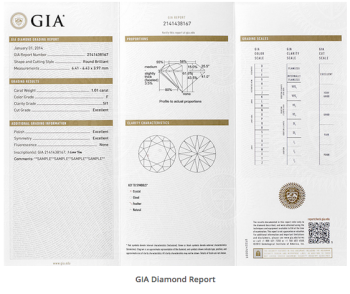
Can A High Quality Diamond Have Pinpoint Inclusions?
Absolutely! While pinpoint inclusions are tiny imperfections within a diamond, they do not necessarily affect its overall quality. In fact, many high quality diamonds can have pinpoint inclusions without compromising their brilliance or value. These inclusions are often so small that they are barely visible to the naked eye, and they can even be hidden by the diamond’s facets. So, if you come across a diamond with pinpoint inclusions, don’t be quick to dismiss it.
Give Us A Shot!
We create custom jewelry made to order. That is all we do. So, if a job requires a diamond, we will get a stone just for the job. That means we take time and care choosing each diamond we put in our jewelry. It also means we will get you the best stone for your money. It also means you have access to ALL the diamonds available at that moment, unlike most jewelers. They will limit you to the stones they have in stock.
So next time you are looking for diamond jewelry, why not go custom made? Why buy a mass produced piece of jewelry when you can have something made that shows your style and personality? And many times, custom jewelry can cost less than a comparable item at the retail stores due to their markup.
Click here to see all of our custom engagement rings. If you don’t see anything you like or can modify to your taste, send us your idea. We will see what we can do for you.

